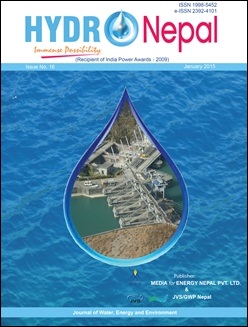Estimating Tunnel Strain in Weak and Schistose Rock Mass under a State of in-situ Stress Anisotropy
DOI:
https://doi.org/10.3126/hn.v16i0.12212Keywords:
Tunnel, Schistose rock, Squeezing, Phyllite, NepalAbstract
Tunnels excavated in weak and schistose rock mass below high overburden (rock cover) are prone to instability in the form of tunnel deformation. The deformation in the tunnel takes place to such an extent that it is irreversible and of significant magnitude, which is often known as tunnel squeezing. In order to limit such plastic deformation in tunnels, it is desirable that the response of the rock mass to induced stresses is known so that requirement of rock support can be estimated. Contrary to the assumption of uniform in-situ stresses made in analytical solutions for elasto-plastic analyses, large degree of stress anisotropy condition prevails in most tunnelling conditions. The effect of such anisotropic stress condition leads to varying degrees of deformations around the tunnel contour. Therefore, stress anisotropy is also an important factor that needs to be addressed to ensure a proper support design for tunnels.
This paper discusses the inter-relationship among rock mass property, in-situ stresses including horizontal to vertical stress ratio, tunnel support pressure and deformation. The study is based on the tunnel cases from the Nepal Himalaya. Three completed tunnel projects were selected, where moderate to large tunnel deformations had been recorded. Long term deformation records were analyzed to assess time independent and time dependent deformations. Results of the analyses of the tunnels in weak and schistose rock mass at stress anisotropy states show that a good correlation among tunnel strain, rock mass shear modulus, support pressure, vertical stress and stress ratio of horizontal to vertical stresses exists. Moreover, the study also shows that significant amount of time dependent deformation can occur in such weak rock mass. Such deformation was found to be high in schist and micaceous phyllite, moderate in graphitic phyllite and low in siliceous phyllite. The suggested relationships can be used as a basis for an early estimate of instantaneous and final deformations and the corresponding requirement of support pressures in tunnel walls in weak and schistose rock mass.
DOI: http://dx.doi.org/10.3126/hn.v16i0.12212
HYDRO Nepal
Journal of Water Energy and Environment
Issue. 16, 2015 January
Page: 7-13
Upload date: March 1, 2015
Downloads
1109
1362
Downloads
Published
How to Cite
Issue
Section
License
The copyright of the articles and papers published is held by HYDRO Nepal Journal.
The views and interpretation in this journal are those of author(s), and HYDRO Nepal does not bear any responsibility for the views expressed by authors in the journal.




